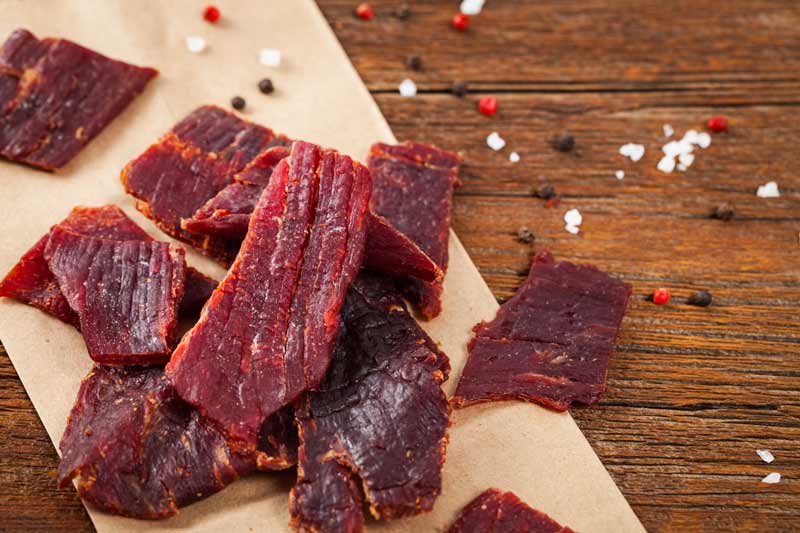Table of Contents[Hide][Show]
Beef jerky is a popular, high-protein snack that many people enjoy for its convenience and long shelf life.
But if you have type 2 diabetes or prediabetes, you may be wondering: Is beef jerky a healthy choice, or does it spike blood sugar?
The answer depends on the ingredients, how it’s made, and how it fits into your overall diet. Let’s break down the facts so you know how to choose.
Beef Jerky: Nutrition Breakdown
Beef jerky is made by drying and curing strips of beef, typically seasoned with salt, spices and sometimes sugar.
Because it’s a high-protein, low carbohydrate snack, it can be a good option for people with diabetes—if you choose wisely.
Here’s a basic nutrition profile per 1-ounce (28-gram) serving of traditional beef jerky:
- Calories: ~80-110
- Protein: 9-12g
- Fat: 1-7g (varies by brand)
- Carbohydrates: 3-8g
- Sugar: 2-6g
- Sodium: 300-700mg
The low carb, high-protein content makes beef jerky generally blood sugar-friendly, but there are a few concerns—especially added sugar, sodium and preservatives.

Does Beef Jerky Affect Blood Sugar?
Beef jerky itself does not contain enough carbohydrates to cause a significant blood sugar spike. However, many brands add sugar, honey or corn syrup, which can raise carbohydrate content.
Added Sugar in Beef Jerky
Some brands include 2-6 grams of sugar per serving, which might seem small, but it adds up—especially if you eat multiple servings.
For comparison:
- Plain beef jerky: 0g sugar per serving
- Mango beef jerky: ~4g sugar per serving
- Honey glazed beef jerky: ~7g sugar per serving
Since sugar intake can raise blood sugar levels, it’s best to choose beef jerky with little to no added sugar (preferably 2g or less per serving).

Beef Jerky and Sodium: A Concern for Heart Health?
One major concern with beef jerky is its high sodium content. Some brands have over 700mg per serving, which can quickly add up, especially for those watching their blood pressure or cardiovascular health.
Since people with type 2 diabetes are at higher risk of high blood pressure and heart disease, excessive sodium intake should be avoided. The general recommendations are to limit sodium intake to a maximum of 2,300mg per day.
If you’re choosing beef jerky, look for lower-sodium options with less than 400mg per serving.
Is Beef Jerky Processed? Are There Any Health Risks?
Most store-bought beef jerky is processed and may contain preservatives like nitrates and nitrites, which have been linked to increased inflammation and potential health risks.
Are Nitrates and Nitrites Bad?
Some research suggests that nitrates and nitrites—found in cured lunch meats—might be linked to an increased risk of insulin resistance and type 2 diabetes. However, the evidence isn’t entirely conclusive.
To avoid unnecessary additives, opt for:
✔ Nitrate-free or uncured beef jerky
✔ Grass-fed beef jerky, which has better fat composition
✔ Minimal ingredient lists (just beef, salt and spices)
Does Beef Jerky Fit Into a Diabetes-Friendly Diet?
Yes! Beef jerky can fit into a diabetes-friendly eating plan—if you pick the right kind.
It provides high-quality protein that helps stabilize blood sugar, curb hunger, and support muscle maintenance (important for metabolism).
For a blood sugar-friendly snack:
- Pair beef jerky with nuts for healthy fats and fiber
- Add cheese or a boiled egg for a balanced low carb snack
- Look for sugar-free, nitrate-free jerky
Best Beef Jerky Brands for Diabetics
Some brands that offer low-sugar, nitrate-free options include:
- Chomps Original Beef Stick (zero sugar, low sodium)
- Epic Provisions Beef Jerky (grass-fed, minimal ingredients)
- Tillamook Zero Sugar Beef Jerky (zero sugar, low carb)
Always read the label—even if it says “low carb” or “healthy.”
Final Verdict: Is Beef Jerky OK for Diabetics?
✅ Yes—IF you choose wisely!
Beef jerky is a high-protein, low carb snack that won’t spike blood sugar, making it a good choice for people with type 2 diabetes or prediabetes.
However, many store-bought brands contain added sugar, high sodium and preservatives, which are best minimized in a quality diabetes nutrition plan.
Best Practices for Eating Beef Jerky with Diabetes:
✔ Choose sugar-free, low-sodium, nitrate-free options
✔ Limit portion sizes (watch for hidden carbs)
✔ Pair with fiber and healthy fats for balanced snacking
Just be sure to read the label carefully and go for clean, minimally processed beef jerky options!

Leave a Reply